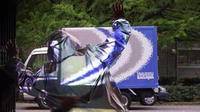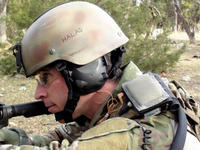-
Invisibility cloaks are hiding around the corner

In 1897 H. G. Wells created a fictional scientist who became invisible by changing his refractive index to that of air, so that his body could not absorb or reflect light; more recently, Harry Potter disappeared from sight after wrapping himself in a cloak spun from the pelts of magical herbivores; now, a Michigan Technology University researcher has found ways to use magnetic resonance to capture rays of visible light and route them around objects, rendering those objects invisible to the human eye
-
-
Engineers use Xbox Kinect to find earthquake survivors
A team of engineers at the University of Warwick in the United Kingdom has been working to develop a robot capable of entering unstable buildings and searching for survivors, such as the 200 purportedly missing after the 6.3 magnitude earthquake in Christchurch, New Zealand; until now, technology has relied on expensive laser-based equipment, but Warwick’s team has reconfigured Microsoft’s Xbox Kinect to identify places in which survivors may be
-
-
Engineering competition features Blue Tooth-capable trebuchet
During the first Storm the Citadel Trebuchet Competition in Charleston over the weekend, Google employees combined Android cell phones, a computer the size of a credit card, and a Blue Tooth receiver to trigger a medieval weapon used in the twelfth century to destroy enemy fortifications
-
-
Wine testing technology to scan for liquids at airports
Scanner technology originally developed at the University of California, Davis, to test wine in the bottle is being re-engineered to tell shampoo from explosives at airports; this means travelers could be able to carry soda cans or full-size tubes of toothpaste through security and onto jetliners in the not-too-distant future
-
-
Acoustic gunfire detection devices heading to the field

Technological developments may one day create artificial soldiers, but until they come along, the United States and other countries will continue to rely on human soldiers; the militaries thus want to preserve as many of their soldier’s lives as possible; to that end, Shoulder-Worn Acoustic Targeting System (SWATS), which helps Marines zero in on enemy sniper fire, is a godsend to the United States; asymmetric warfare favors the forces that can strike and runaway unharmed, but with plentiful acoustic sensors in the field it will be that much harder for snipers to ambush U.S. soldiers and live to escape
-
-
To boldly go -- but at a leisurely pace
In 1961 President John Kennedy committed the United States to land a man on the moon “before this decade is out”; DARPA new space project has a more lackadaisical time table: building an interstellar starship capable of carrying people to other star systems than our own by the year 2100AD
-
-
Aussie "thinking cap" makes brain waves
Scientists in Australia say they are encouraged by initial results of a revolutionary “thinking cap” that aims to promote creativity by passing low levels of electricity through the brain; the device works by suppressing the left side of the brain, associated with knowledge, and stimulating the right side, linked to creativity.
-
-
A fast, simple test for detecting cholera
The new detection method uses specially prepared nanoparticles of iron oxide, each barely 1/50,000th the width of a single human hair, coated with a type of sugar called dextran; to achieve this, the scientists looked for specific characteristics of the cholera toxin receptor (GM1) found on cells’ surface in the victim’s gut, and then they introduced these features to their nanoparticles; when the magnetic nanoparticles are added to water, blood, or other fluids to be tested, the cholera toxin binds to the nanoparticles in a way that can be easily detected by instruments
-
-
Smart fence distinguishes real from imagined threats
A new sensor system can tell between someone simply leaning against a fence and a ne’er-do-well sneaking around; the device, developed by researchers at the University of Southern California, contains signal processing based on the way the brain works
-
-
Breakthrough in free-electron laser development
Breakthroughs in Free-Electron Laser (FEL) technology could mean a virtually impenetrable defense system for Navy ships; the laser weapon has the capability to detect and engage incoming cruise missiles at the speed of light without running out of ammunition
-
-
iPhone app helps police "see" through walls
Law enforcement officials are using SafetyNet Mobile, a powerful new iPhone app, to fight crime; the app allows police officers to quickly access all emergency dispatch information including maps, warnings, hazard information, and other critical data; to access the emergency dispatch database, the officer simply points the iPhone or iPad’s camera at a location; this technology allows police to “see” behind doors or walls by alerting them to any potential dangers inside; the app installs on any iPhone or iPad; SafetyNet Mobile has been successfully tested by three police departments in California and is currently being rolled out
-
-
Beaming rockets into space
Space launches have evoked the same image for decades: bright orange flames exploding beneath a rocket as it lifts, hovers, and takes off into the sky; an alternative propulsion system proposed by some researchers could change that vision; instead of explosive chemical reactions on-board a rocket, the new concept, called beamed thermal propulsion, involves propelling a rocket by shining laser light or microwaves at it from the ground; with the beam shining on the vehicle continually, it would take eight to ten minutes for a laser to put a craft into orbit, while microwaves would do the trick in three to four minutes
-
-
New bomb detection tool: Ferns
Researchers engineered fern proteins to turn airport plants into bomb detectors; the researchers rewrite the fern’s natural signaling process so the plant turns from green to white when chemicals are detected in air or soil
-
-
"Sniffer technology" may replace detection dogs
Humans have approximately 5,000,000 sensory “smelling” cells, while certain breeds of dogs, such as the Alsation, can have up to 220,000,000; dogs trained for detection jobs are effective enough, but require much more maintenance than a machine — and researchers have just developed a sniffer machine which may well compete with dogs; the new device uses what is called quantum cascade (QC) lasers to detect any trace vapors of explosive material emitted by a passenger, without the passengers having to remove any article of clothing in the process
-
-
Camera better than the human eye
Researchers developed a curvilinear camera, much like the human eye, with the significant feature of a zoom capability, unlike the human eye; the “eyeball camera” has a 3.5x optical zoom, takes sharp images, is inexpensive to make and is only the size of a nickel; the camera will not be appearing at Best Buy any time soon, but the tunable camera — once optimized — should be useful in many applications, including night-vision surveillance, robotic vision, endoscopic imaging, and consumer electronics
-
More headlines
The long view
New Technology is Keeping the Skies Safe
DHS S&T Baggage, Cargo, and People Screening (BCP) Program develops state-of-the-art screening solutions to help secure airspace, communities, and borders
Factories First: Winning the Drone War Before It Starts
Wars are won by factories before they are won on the battlefield,Martin C. Feldmann writes, noting that the United States lacks the manufacturing depth for the coming drone age. Rectifying this situation “will take far more than procurement tweaks,” Feldmann writes. “It demands a national-level, wartime-scale industrial mobilization.”
How Artificial General Intelligence Could Affect the Rise and Fall of Nations
Visions for potential AGI futures: A new report from RAND aims to stimulate thinking among policymakers about possible impacts of the development of artificial general intelligence (AGI) on geopolitics and the world order.
Keeping the Lights on with Nuclear Waste: Radiochemistry Transforms Nuclear Waste into Strategic Materials
How UNLV radiochemistry is pioneering the future of energy in the Southwest by salvaging strategic materials from nuclear dumps –and making it safe.
Model Predicts Long-Term Effects of Nuclear Waste on Underground Disposal Systems
The simulations matched results from an underground lab experiment in Switzerland, suggesting modeling could be used to validate the safety of nuclear disposal sites.
